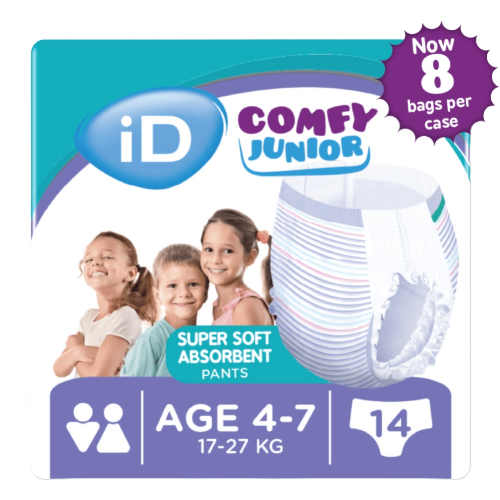Understanding Bedwetting: A Caring Guide for Parents
Parenting comes with a wide range of challenges, and one of the less-discussed topics is bedwetting. For many children, this condition can be a source of stress, embarrassment, and even isolation. As a parent, you may feel unsure about how to support your child, but remember that you are not alone, and there are solutions. With the right information and approach, you can help your child navigate this phase with confidence and security. In this blog, we’ll explore what bedwetting is, its causes, and how iD Junior can make a positive difference for your family.

What is bedwetting?
It is the involuntary release of urine, typically during sleep, in children who are old enough to control their bladder. While often harmless, bedwetting can affect a child’s self-esteem and emotional well-being if not addressed with sensitivity and care.

Causes of Bedwetting
There are many factors that may contribute to bedwetting, including:
- Delayed Bladder Development: Some children’s bladders take longer to mature, leading to less control during the night.
- Deep Sleep Patterns: Children who are deep sleepers may not wake up when their bladder signals the need to urinate.
- Family History: Genetics can play a role, as bedwetting often runs in families.
- Stress or Anxiety: Emotional challenges, like changes at home or school, can exacerbate the condition.
Medical Issues: While rare, conditions like urinary tract infections or diabetes can contribute to enuresis.

How Parents Can Support Their Children
Helping your child through bedwetting requires patience, understanding, and a proactive approach. Here are some steps parents can take:
A Supportive Parenting Guide for Managing Bedwetting
Bedwetting is a natural part of childhood for many, and it’s crucial to approach it with care, patience, and understanding. It’s not a behavior to punish or shame—it’s a phase that many children outgrow with time. Here’s a thoughtful guide to help you support your child, manage the challenges, and foster their confidence.
1. Create a Supportive Environment
Reassure your child that bedwetting is normal and happens to many children. Explain that it’s not their fault, and they are not alone in this experience. Remind them of your love, no matter what, so they understand this is not something to feel ashamed about.
Empathize with their feelings: If your child seems upset or embarrassed, listen to them and validate their emotions. You might say, “I know this can feel frustrating, but it’s not something you can control right now, and it will get better.”
Avoid punishment or blame: Scolding or making them feel bad won’t help resolve the issue. Instead, focus on positive reinforcement and comfort.
Creating a safe and non-judgmental space allows your child to feel more secure as they learn to manage this phase in their growth.
2. Encourage Healthy Habits
Supporting your child with small, manageable habits can help minimize the likelihood of bedwetting accidents and provide a sense of routine. While these steps won’t offer an instant solution, they can gently guide their body toward more reliable patterns over time.
Limit evening fluids wisely: Encourage your child to drink plenty of water throughout the day but reduce heavy fluid intake in the hour or two before bedtime. This isn’t to withhold water but to prevent pressure on the bladder during the night.
Set a bedtime bathroom routine: Remind your child to go to the toilet before getting into bed. You can even make this part of a calming nighttime routine to help them relax for sleep.
Regular bathroom breaks during the day: Ensure your child visits the toilet regularly throughout the day to help train their bladder and build awareness.
Be gentle when encouraging these habits. Frame them positively as part of growing up rather than treating them as a solution to a "problem."
3. Use Practical Solutions for Peace of Mind
Managing the physical side of bedwetting can make a world of difference in lowering stress for both you and your child. Knowing you have measures in place can help them feel less self-conscious and more at ease.
Protect the bedding: Invest in waterproof mattress covers or liners to make cleanup easier and keep their sleeping space dry and comfortable. These are discreet and ensure bedwetting doesn’t disrupt the household.
Use absorbent products: There are nighttime pull-ups and underwear designed for older children, offering protection without drawing attention. Encourage these as a tool, not a crutch, and ensure your child understands it’s temporary as their body matures.
Plan for easy cleanups: Keep fresh bedding and a clean set of pajamas nearby, so any accidents can be quickly managed without any fuss or interruptions to their sleep.
Approaching accident management without making it a "big deal" helps your child feel less embarrassed and more secure.
4. Consult a Professional if Needed
While most cases of bedwetting resolve on their own, there are instances when professional advice can help. If bedwetting persists past the age of 7 or if you notice warning signs like pain during urination, day-wetting, or sudden onset after being dry, it’s essential to consult a pediatrician.
Doctors can help rule out underlying medical conditions, such as urinary tract infections, bladder issues, or stress-related factors, and they might recommend strategies or treatments tailored to your child’s specific needs. Knowing when to seek guidance is an act of care, not overreaction.
5. Practice Endless Patience and Offer Unwavering Support
Bedwetting is often more stressful for your child than it is for you. They might already feel embarrassed or frustrated, so your patience can act as a balm for their worries. Celebrate dry nights with encouragement, but avoid overly focusing on setbacks—progress is rarely linear, and that’s okay.
Be their cheerleader: Celebrate their efforts without pressuring them for results. A simple “I’m proud of how you’re doing your best” can mean a lot.
Foster their confidence: Remind your child that bedwetting is temporary and something they will overcome in time. Share stories of others who’ve grown out of it to show they’re not alone.
Bedwetting is a phase, not a flaw. With love, reassurance, and practical strategies, you and your child can work through this together. Remember, your calm and understanding presence is the most significant support you can offer during this stage of their childhood.

How iD Junior Can Help
iD Junior is specifically designed to support children experiencing bedwetting with care and understanding. Here’s how our products can make a difference:
Comfort and Fit: iD Junior ensures a close fit that stays in place when wearing, providing ultimate comfort.
Reliable Protection: The high-absorbency design keeps moisture locked away, so your child wakes up feeling dry and confident.
Discreet Design: With a discreet, child-friendly look, iD Junior empowers children to feel secure without embarrassment.
Ease for Parents: These products simplify clean-up and reduce stress, allowing families to focus on creating a positive bedtime routine.

Making Memories: Fun Holiday Activities for Parents and Children
The holiday season is a time for family, joy, and togetherness. For parents, it's also the perfect opportunity to create cherished memories with their children. Spending quality time together during the festive break is not only fun, but it also strengthens family bonds and passes down traditions that can last a lifetime. Here are some enjoyable and meaningful activities that parents can do with their children during the Christmas holidays.

1. Bake Holiday Treats Together
Baking can sometimes get a bit messy-make sure you're prepared with iD's protective pads, perfect for staying dry and comfortable while you enjoy baking with the family. Parents can share traditional family recipes, creating a delicious way to pass on family history.

2. Create Handmade Ornaments
Making ornaments together is a creative way for parents and children to bond while adding a personal touch to the holiday decor.

3. Write Letters to Santa (or to Each Other)
Writing letters to Santa is a classic activity for children, but parents can join in the fun too! Help your children craft their letters, asking what they’re most excited for and what they wish for others. Alternatively, write letters to each other to be opened on Christmas morning. These can be filled with loving words, favorite memories from the year, or heartfelt messages, creating a beautiful holiday keepsake.
4. Go on a Holiday Lights Walk
For outdoor adventures like holiday light walks, iD products offer reliable protection so you can focus on enjoying the magic of the moment with your children. Wonderful way for parents to spend some quality outdoor time together. You can even make a game out of it by creating a scavenger hunt - see who can find the most reindeer or spot a snowman first!

5. Host a Family Movie Marathon
Watching these films together is a wonderful way to slow down, relax, and enjoy each other's company while soaking in the holiday spirit.
6. Create a Memory Scrapbook
Creating a memory scrapbook is a fantastic way to document the holiday season. Print out photos, collect keepsakes like ticket stubs or drawings, and put them all together in a scrapbook. Let the children help by adding captions, stickers, or drawings. Parents can share stories from their past holidays, helping kids connect with family traditions. This scrapbook will serve as a cherished memory for years to come.
7. Read Holiday Stories Together
Reading is a great way to calm down after an exciting day. Choose classic holiday stories and take turns reading them aloud. Parents can share some of their favorite childhood books and introduce new ones. Reading together encourages a love of literature and creates special moments of connection, especially when everyone is cozied up by the fireplace.

8. Plan a Holiday Scavenger Hunt
Create a scavenger hunt for the children to find small gifts or treats hidden around the house. Parents can work together to come up with clues, and children can use their detective skills to find the surprises. It’s a fun activity that keeps the kids engaged and adds a little adventure to the holiday festivities.
9. Make Homemade Holiday Cards
Crafting holiday cards together is a wonderful way to spread joy. Parents can guide their children in making cards for other family members, friends, or even neighbors. Let the kids get creative with drawing, gluing, and adding personal messages. These handmade cards are sure to bring a smile to anyone’s face and are a thoughtful way to involve children in the act of giving.
10. Sing Christmas Carols
Nothing says holiday fun like singing carols or having a dance party in the living room. Sing some classic carols together or turn on your favorite festive playlist and dance to the tunes. Parents can teach traditional songs while the kids add their own dance moves, filling the home with laughter and cheer.

Create Cherished Holiday Memories with iD's discreet and effective products, you can embrace every holiday activity confidently, knowing you're supported. Let nothing hold you back from creating beautiful memories with your loved ones. Whether you're baking, crafting, singing, or just spending time by the fireplace, these moments are what make the holidays truly special.
Explore our incontinence products here
Support for Caregivers: A Guide to Confident and Compassionate Care
Caring for a loved one with incontinence can be a challenging journey, but it’s also an act of love and strength. As an informal caregiver, you are not alone, and the emotions you feel—from frustration to deep empathy—are valid. Here’s how to support your loved one with confidence and compassion, while also taking care of yourself.

1. Understanding Their Emotions
Incontinence can deeply impact a person’s sense of dignity and independence. Your loved one might feel embarrassment or shame, and it's important to reassure them that these feelings are okay. Practice empathy by listening to their concerns without judgment and reminding them that incontinence is a common health condition that doesn’t define who they are. Encourage them to express their feelings openly and validate their experiences by acknowledging their emotions.
Practical Tip: Use reassuring phrases like, "I understand this is difficult for you, and I’m here to help." Avoid dismissing their feelings, and instead, offer comfort by being patient and present.

2. Building Trust Through Routine
Establishing a daily routine can help create a sense of stability and comfort for both you and your loved one. Consistency in care can reduce anxiety and allow them to feel more in control. Let them be involved in decisions about their care whenever possible, from choosing the right products to deciding on their daily activities.
Practical Tip: Create a visual schedule that includes mealtimes, hygiene routines, and enjoyable activities. This can help your loved one anticipate what’s coming next and feel more in control of their day.
Psychological Insight: Predictable routines can reduce stress and foster a sense of safety. Involving your loved one in decision-making can also help rebuild their confidence and autonomy.

3. Gentle Communication is Key
When discussing incontinence, choose your words with care. Use gentle language that respects their dignity, avoiding phrases that may feel clinical or impersonal. Your words can be powerful tools in helping your loved one feel valued and understood.
Practical Tip: Instead of saying, "It’s time to change your diaper," try saying, "Let’s get you more comfortable." Small changes in language can have a big impact on preserving dignity.
Psychological Insight: Using positive and non-judgmental language helps reduce the stigma around incontinence and supports emotional well-being. Communication should be empathetic, focusing on comfort and care rather than the condition itself.
4. Self-Care for You as a Caregiver
It’s easy to forget about your own needs when caring for someone else. However, taking time for yourself isn’t selfish—it’s essential. Find small moments for activities you enjoy, whether it’s reading, walking, or simply relaxing. Remember that your well-being is crucial to providing compassionate care.
Practical Tip: Set aside at least 15-30 minutes each day for yourself. Use this time to do something that relaxes or energizes you, like practicing deep breathing, taking a walk, or connecting with a friend.
Psychological Insight: Caregiver burnout is real, and prioritizing your own needs helps prevent it. By taking care of yourself, you are ensuring that you have the energy and emotional capacity to provide the best possible care for your loved one.
5. Celebrate Small Wins Together
Recognize and celebrate the small victories. Whether it’s a day without leaks, a successful outing, or simply a moment of laughter, acknowledging these moments can strengthen your bond and bring positivity to the care experience. These shared moments remind both of you that progress comes in different forms.
Practical Tip: Keep a journal of positive moments or small achievements. Reflecting on these can help maintain a hopeful outlook and remind both you and your loved one of the progresses being made.
Psychological Insight: Celebrating small wins helps reinforce positive behaviors and creates a sense of accomplishment, which is crucial for maintaining motivation and emotional well-being for both caregiver and loved one.
6. Seek Support When You Need It
Don’t hesitate to seek help from support groups or professional resources. Speaking with others who understand what you’re experiencing can be comforting and provide you with practical tips. It’s okay to admit that you need support too—caregiving is a shared journey, not something you need to handle alone.
Practical Tip: Look for local or online support groups for caregivers. Connecting with others who share similar experiences can provide emotional relief and practical strategies to make caregiving more manageable.
Psychological Insight: Sharing experiences with others helps reduce feelings of isolation and provides a sense of community. Knowing that others face similar challenges can be empowering and help build resilience.
Providing care is a powerful expression of love. By embracing empathy, maintaining open communication, and prioritizing your own well-being, you can support your loved one through their incontinence journey with confidence and compassion.
If you're or your beloved ones are dealing with the symptoms of incontinence, iD provides a full range of products that offer effective and discreet solutions. Our pads, pants, and other incontinence products are specially designed to keep you comfortable, dry, and free from unwanted odors—so you can continue living your active lifestyle with confidence.
Explore our incontinence products here
Supporting Your Child with Incontinence on Halloween: A Parent’s Ultimate Guide
Halloween is a time when imaginations run wild—when kids transform into their favorite superheroes, ghosts, or mythical creatures. The thrill of the night, filled with candy and adventure, should be an experience every child can enjoy without worry. But for parents of children with incontinence, the prospect of navigating a night full of excitement, distractions, and the need for quick bathroom breaks can feel daunting.
This guide isn’t just about managing the night—it’s about transforming Halloween into a joyful, worry-free celebration where your child can shine, costume and all. Let’s dive into creative, thoughtful ways to make this Halloween not just manageable, but magical for your child.

1. Costume Magic: Where Comfort Meets Creativity
The right costume can turn Halloween into a night of pure fun, allowing your child to immerse themselves in the excitement without a second thought. Here’s how to find that perfect balance:
The Power of Capes and Cloaks: These not only add a touch of mystery and magic to any outfit but also provide easy, discreet coverage for incontinence products. Your child can transform into a daring superhero or a mysterious wizard while feeling secure and comfortable.
Elastic and Easy Access: Look for costumes with elastic waistbands or snap closures. A stealthy ninja outfit with stretchy pants or a swashbuckling pirate with a simple sash can make bathroom breaks quick and easy, allowing your child to jump back into the action in no time.
One-Piece Wonders: Jumpsuits with zippers or velcro closures are a fantastic option. They’re easy to slip on and off and can be styled into anything from a zippy race car driver to a cuddly, friendly monster. The key is ease without sacrificing the fun factor.

2. Trick-or-Treating with a Plan: Mastering the Route
Halloween night is all about adventure, and a little bit of planning can ensure its smooth sailing:
The Pre-Game Routine: Before the costume goes on and the candy hunt begins, make sure your child has a final bathroom break. This simple step sets the stage for a worry-free evening.
Map It Out: Plan your trick-or-treating route with strategic stops—whether it’s a friendly neighbor’s house, a local community center, or even a park restroom. This ensures that a quick bathroom break is always just around the corner, so the fun doesn’t have to pause for long.
Pacing the Fun: Trick-or-treating doesn’t have to be a marathon. Plan for mini-breaks where your child can rest, have a sip of water, and, if needed, take a bathroom break. These breaks can be built into the fun—maybe a stop at a house with a particularly spooky display or a mini dance party at a friend’s house.

3. The Ultimate Halloween Toolkit: Be Prepared, Be Confident
Arm yourself with a discreet, stylish bag that holds everything you might need:
Invisibility Cloak (a.k.a. Extra Incontinence Products): Pack a couple of extra incontinence products to ensure your child is prepared for anything. The confidence of being ready can make all the difference.
Wipes and Disposal Bags: Quick, easy clean-ups and discreet disposal are a must. Wipes are your magic wand to keep things fresh and simple.
Costume-Compatible Change of Clothes: A backup outfit that complements your child’s costume can be a lifesaver. If an accident happens, your child can quickly change and get right back into character—no harm, no foul.
4. Empowering Your Child: The Magic of Mindfulness and Positivity
Halloween is meant to be a night of fun, not stress. Equip your child with the tools to feel confident and excited:
Mindfulness in a Minute: Teach your child a simple breathing exercise or a calming phrase they can use if they start to feel anxious. Something like, “I am brave, I am strong, I can have fun all night long!” can be their mantra.
Celebrate the Small Wins: Every successful bathroom break, every time they confidently enjoy a moment in their costume—celebrate it! Your enthusiasm will help reinforce their confidence and keep the night focused on fun.
5. Creating a Supportive Environment: Communicate with Hosts and Friends
If you’re heading to a Halloween party or gathering, a little communication goes a long way:
Friendly Heads-Up: Let the host know about your child’s needs in advance. Most people will appreciate the opportunity to help ensure your child has a great time. A quick conversation about where the bathroom is or a quiet space for a break can make all the difference.
Team Up with Friends: Encourage your child to stick with a buddy during trick-or-treating. A supportive friend can make them feel more at ease and less alone in managing their incontinence.
6. Reimagine the Fun: Focus on the Magic, Not the Challenges
At the end of the day, Halloween is about joy, creativity, and making lasting memories. Keep the focus on what makes your child happiest:
Custom Candy Plan: If candy causes concern, create a trade-in system where your child can swap out some of their loot for a toy, book, or special treat of their choice.
Home-Based Fun: If trick-or-treating isn’t ideal, transform your home into a Halloween haven. Set up a scavenger hunt, host a mini costume party with close friends, or have a Halloween movie marathon. The goal is to keep the spirit of the holiday alive, no matter the circumstances.
Supporting your child with incontinence on Halloween is about more than just managing their needs—it’s about empowering them to enjoy every moment of this magical night. By choosing the right costume, planning strategically, and focusing on mindfulness and fun, you can ensure that Halloween is a night your child will look back on with joy. With a little creativity and preparation, you’ll help your child feel confident, comfortable, and ready to embrace the adventure that is Halloween.
Wear iD Comfy Junior Pants: These absorbent, comfortable, and discreet pants are perfect for children. They look and feel like regular underwear, giving your child the confidence to play, learn, and interact without fear of an accident.
Back to School with Confidence: Tips for Managing Incontinence in the Classroom
Managing Incontinence in the Classroom: A Guide for Parents provides valuable tips and insights for this situation. As the new school year approaches, many parents are busy buying supplies, packing lunches, and preparing their children for the academic adventures ahead. But for parents of children with incontinence, there’s an added layer of preparation: ensuring their child feels confident and secure in the classroom. The good news is that with a bit of creativity and proactive planning, you can help your child tackle the school year with confidence and ease.
Incontinence in children is more common than you might think, and it’s nothing to be ashamed of. Whether it’s daytime wetting, bedwetting, or occasional accidents, these challenges can be managed in a way that allows your child to focus on what really matters—learning, growing, and having fun.

1. Make Incontinence Management Fun and Empowering
One of the best ways to help your child manage incontinence is by making the process feel less like a chore and more like a routine they can be proud of. Here’s how:
- Involve Them in the Preparation: Let your child pick out their own backpack, including a special “secret pocket” for their incontinence essentials. Allowing them to choose their own supplies can make them feel more in control and less anxious.
- Sticker Charts and Rewards: Create a sticker chart at home where your child can track their progress. For example, managing a whole school day without an accident, small rewards can go a long way in boosting their confidence.
- Personalized Hygiene Kits: Help your child put together a personalized hygiene kit that includes extra iD Comfy Junior Pants, wipes, and a change of clothes. Decorate the kit together, so it feels like something special rather than a reminder of their condition.

2. Foster a Positive Mindset at Home
Building your child’s confidence starts at home. By fostering a positive mindset around incontinence, you can help them approach the school day with a smile:
- Normalize the Conversation: Talk about incontinence openly and without shame. Explain that it’s just one small part of who they are, and it doesn’t define them. Share stories of other kids who’ve dealt with similar issues and overcome them.
- Role-Playing Scenarios: Practice different scenarios at home where your child might need to manage their incontinence at school. Role-playing can help them feel prepared and less anxious about the “what ifs.”
- Mindfulness and Relaxation: Teach your child simple mindfulness or breathing exercises to help them stay calm if they feel anxious about incontinence at school. This can be especially helpful in moments when they might feel overwhelmed.

3. Keep a Routine, but Stay Flexible
Consistency is key, but flexibility is also important when managing incontinence. Here’s how to strike that balance:
- Morning Routine: Establish a consistent morning routine that includes a bathroom visit before leaving for school. Make it a calm and relaxed time to help set a positive tone for the day.
- Hydration Balance: Encourage your child to drink water regularly, but not too much at once. Keeping them hydrated is important but managing fluid intake can help prevent accidents.
- Afternoon Check-Ins: When your child comes home from school, have a quick, positive check-in about how their day went. Celebrate successes and talk through any challenges in a supportive way.
4. Equip Your Child with Confidence Tools
Confidence isn’t just about what’s on the inside—it’s also about feeling secure in practical ways!
Wear iD Comfy Junior Pants: These absorbent, comfortable, and discreet pants are perfect for children. They look and feel like regular underwear, giving your child the confidence to play, learn, and interact without fear of an accident.








